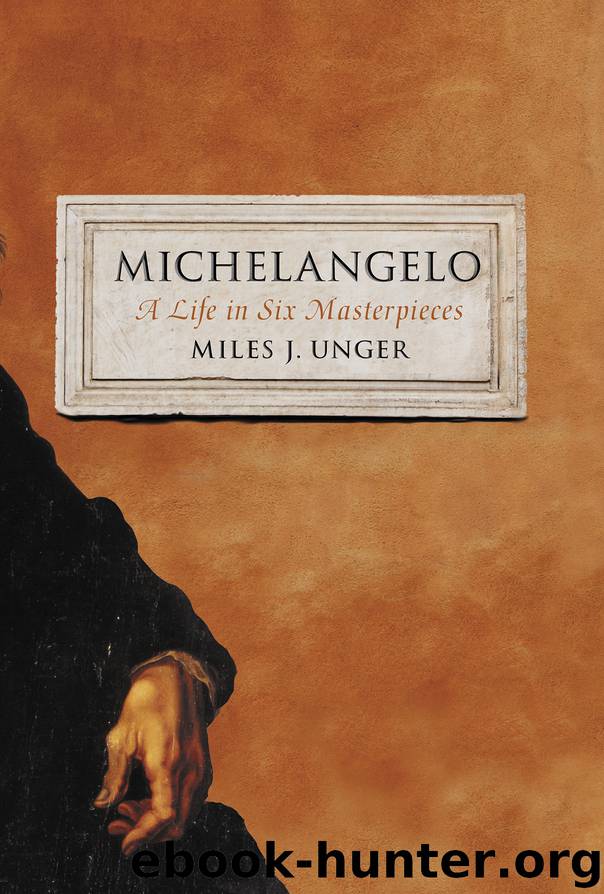Michelangelo by Miles J. Unger

Author:Miles J. Unger
Language: eng
Format: epub
Publisher: Simon & Schuster
IV. AGE OF ANXIETY
The quarrel with his father increased Michelangelo’s sense of isolation; all the world seemed to have turned against him, and he was left feeling exhausted and dispirited. Ultimately, he was willing to pay a steep price to buy back his honor. Prodded by the cardinal, he finally agreed to accept an allowance, but only if it was reduced to a paltry 15 ducats per month, a stipend Fattucci described as “shameful.” Two years later, in April 1525, he declared himself ready to admit his fault if only this would get his creditors off his back. “They can’t sue me if I admit that I’ve done wrong,” he pointed out.
I’ll act as if I’ve been taken to court and lost and must give them satisfaction. And this I’ll do, if I can. But if the Pope wishes to help me in this matter—which would give me great pleasure, seeing that, either from old age or infirmity I will never finish the Julius’s tomb—he, in his role as middleman, can say that he wishes me to restore what I’ve received for completing it, so that I can be free of this burden, and the relatives of the said Pope, having obtained restitution, can give the job to whomever they choose and have it made as they wish.
Even as he cast about for a way to satisfy both the cardinal and the heirs of Pope Julius, he continued to work sporadically on the tomb in his Florentine studio. It was during these unhappy years that he began the four magnificent Captives now in the Accademia Gallery in Florence. Though he finished none of them, they are among the most powerful in Michelangelo’s entire oeuvre. Only partially released from the surrounding matrix of stone, each seems to struggle against his fate, engaged in a Manichaean contest of pure spirit against corrupt matter. For Neoplatonists like Pico della Mirandola, the body is the prison of the soul, released only in death. “Through the first death, which is only a detachment of the soul from the body . . . the lover may see the beloved celestial Venus,” Pico declares, “but if he would possess her more closely . . . he must die the second death by which he is completely severed from the body. . . .” In his own writings, Michelangelo often expresses a similar idea, at one point transcribing Petrarch’s famous line “Death is the end of a dark prison.” The sculptor, probing the inarticulate mass with his chisel, finding form within formlessness, replicates the kiss of death, a stripping down to bare essentials that releases the soul from its fleshy cage.
More than any artist in history, Michelangelo left behind an impressive body of half-completed works, many of which are masterpieces in their own right. In fact, a list of his unfinished works would be far longer than a list of paintings and sculptures fully executed. But even works like the New Sacristy or the captives meant for Julius’s
Download
This site does not store any files on its server. We only index and link to content provided by other sites. Please contact the content providers to delete copyright contents if any and email us, we'll remove relevant links or contents immediately.
| Africa | Asia |
| Canadian | Europe |
| Holocaust | Latin America |
| Middle East | United States |
Fanny Burney by Claire Harman(26510)
Empire of the Sikhs by Patwant Singh(22965)
Out of India by Michael Foss(16780)
Leonardo da Vinci by Walter Isaacson(13151)
Small Great Things by Jodi Picoult(6974)
The Six Wives Of Henry VIII (WOMEN IN HISTORY) by Fraser Antonia(5381)
The Wind in My Hair by Masih Alinejad(5023)
A Higher Loyalty: Truth, Lies, and Leadership by James Comey(4822)
The Lonely City by Olivia Laing(4731)
The Crown by Robert Lacey(4710)
Millionaire: The Philanderer, Gambler, and Duelist Who Invented Modern Finance by Janet Gleeson(4353)
The Iron Duke by The Iron Duke(4275)
Papillon (English) by Henri Charrière(4178)
Sticky Fingers by Joe Hagan(4087)
Joan of Arc by Mary Gordon(4000)
Alive: The Story of the Andes Survivors by Piers Paul Read(3956)
Stalin by Stephen Kotkin(3865)
Aleister Crowley: The Biography by Tobias Churton(3573)
Ants Among Elephants by Sujatha Gidla(3402)
